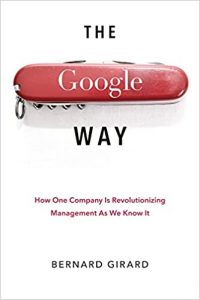
3 simple principles that you can take away from Google:
1.Attracting inspired people-
Inspired employees are more important than inspiring leaders. This can be achieved by creating the right company culture. A great set of values attract the right kind of people.
2. Make sure everyone is happy when a decision is made-
The only way to keep employees bright, creative and motivated, is to treat them as equals when making decisions. In doing so, employees will always support the final decision.
3. Employees need space to be creative-
An organization must aim to create an environment where employees want to work, but not told how to think. Creativity is essential to produce great ideas and products, therefore, forming a company culture that encourages creativity is vital.
Core principles:
Design platforms, not products:
With the vast access to knowledge, computing, connectivity, and manufacturing, the global scale is within everybody’s grasp. To prosper in the internet age, leaders must develop and grow platforms that connect customers and create multi-faceted markets.
Technical Insights > Market Research:
Technical insights utilise technology and design to reduce expenses and increase the functionality of the product or service. Unlike products based on market research, the outcome is a much more viable product compared to existing competition.
Open to being Open:
The internet age benefits public sharing of intellectual property and offering clients the freedom to exit. Such openness gives your business scale and innovation.
Don’t Follow Competition:
The role of a disruptive organization is to create things that don’t even exist yet. Obsession with competition can be detrimental to innovation.
Some management principles:
Keep interviews short:
Restrict interviews to 30 minutes to enhance focus. If a candidate is good, you can always schedule another one. Google’s internal research discovered that after 4 interviews, the expense of an extra interview exceeds the added value created.
Set the bar high:
Aim for creating an environment of innovation and creativity. The bar has to be set high from the very beginning.
Hire talent:
Hire great talent who may not match your ideal requirements, titles, and expertise, and challenge them to do new things.
Use committees:
Decisions must be made by committees, instead of managers. To recruit someone, the committee needs to approve based on data. In the same way, promotions are decided by committees with the manager having only the ability to recommend.
# Key Takeaways:
– Google’s success is attributed to its unique culture and management style, which values innovation, collaboration, and employee empowerment.
– The company’s “20% time” policy, where employees are encouraged to spend one day a week working on personal projects, has led to many successful products and ideas.
– Google’s hiring process is rigorous and focuses on finding the best talent, rather than just filling positions.
– The company’s flat organizational structure and lack of hierarchy allows for open communication and quick decision-making.
– Google’s emphasis on data-driven decision making and experimentation has helped the company stay ahead of its competitors.
# Practical Application:
– Companies can adopt Google’s “20% time” policy to encourage innovation and creativity among employees.
– Embracing a flat organizational structure and promoting open communication can lead to faster decision-making and a more collaborative work environment.
– Implementing a rigorous hiring process can help companies find the best talent and build a strong team.
– Using data to drive decision-making and constantly experimenting can help companies stay ahead of the curve and adapt to changing market conditions.
# Valuable Insights for Leaders and Managers:
– Chapter 3, “The Google Culture,” offers valuable insights into Google’s unique culture and how it contributes to the company’s success.
– Chapter 4, “The Google Hiring Process,” provides valuable tips and strategies for hiring top talent.
– Chapter 5, “The Google Management Model,” offers insights into Google’s flat organizational structure and management style.
– Chapter 6, “The Google Innovation Machine,” discusses how Google fosters innovation and creativity among its employees.
# Case Studies and Examples:
– The case study of Google’s acquisition of YouTube in Chapter 7 illustrates the company’s data-driven decision-making process.
– The example of Google’s “20% time” policy leading to the creation of Gmail in Chapter 8 showcases the success of this approach.
– The case study of Google’s “Project Oxygen” in Chapter 9 demonstrates how the company uses data to improve its management practices.
– The example of Google’s “20% time” leading to the creation of Google News in Chapter 10 highlights the benefits of employee empowerment and autonomy.
Leave a Reply